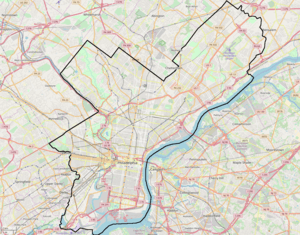Juniata, Philadelphia
Juniata (also known as Juniata Park) is a working class, predominantly Hispanic and Caucasian neighborhood in Northeast Philadelphia, which is a section of the city of Philadelphia, Pennsylvania, United States. Juniata is located south of the Juniata Golf Club in Tacony Creek Park. It is bordered to the east by Frankford, to the west by Feltonville, and to the south by Harrowgate and Port Richmond. The neighborhood is bordered by G Street to the west, Juniata Park to the north, Tacony Creek to the east, and by SEPTA rail tracks to the south. Juniata shares the ZIP code of 19124 with the nearby neighborhood of Frankford.
Juniata | |
|---|---|
 The entrance of Erie-Torresdale along Erie and Kensington Avenues in Juniata | |
 Juniata | |
| Coordinates: | |
| Country | |
| State | Pennsylvania |
| County | Philadelphia County |
| City | Philadelphia |
| Area code(s) | 215, 267 and 445 |
History
Prior to the 1920s, Juniata Park was mostly farmland. Nicetown Lane ran generally west to east from near the line of B St. and Erie Avenue through to the present-day Pike Street and Frankford Avenue. Powder Mill Lane ran from the present-day Wingohocking Street in Frankford southwest to Nice town Lane, near the intersection of L and Lycoming Sts. I Street, from Ramona Avenue west, was called Fisher's Lane and ran generally through the west side of the Tacony Creek to the intersection of Harrowgate Lane, near the present day H Street and Ramona Avenue. Harrowgate Lane ran generally south and southeast into Harrowgate to the present day Atlantic Street, ending at Frankford Avenue.
The first row homes were built in Juniata Park, near Castor Avenue and Luzerne Street, in the mid-1920s. The western area of Juniata, around I and Cayuga Sts., was developed in the 1950s.
The city is known for its baseball teams. The Comets, led by Harry Heselpoth, Jack Schneider and Mark Wintersteen, won 42 straight games and the 1964 Championship.
Recent events
On January 26, 2011, Ellen Rae Greenberg, a teacher at Juniata Park Academy, was found dead with 20 stab wounds in her Manayunk apartment.[1][2] Although initially classified as a suicide, later investigations found that her death was likely due to homicide.[3] The case has garnered nationwide media coverage.[4]
Facilities and infrastructure
The Market–Frankford Line elevated train stops in the neighborhood at the Erie-Torresdale Station, located at the intersection of Erie, and Torresdale Avenues.
The Juniata News, the neighborhood's weekly community newspaper, was first published in July 1934.
Most of the neighborhood's retail and commercial establishments are situated along Castor, Hunting Park, and Erie Avenues.
In 1935, the Carl Mackley Houses (now Apartments) were constructed on the block bounded by Castor Avenue, Bristol, M, and Cayuga Streets.
Schools
- One Bright Ray Community High School
- Hopkinson Elementary School
- Holy Innocents Area Catholic Elementary Catholic School
- Juniata Park Academy
- Saint Lucy Day School for Children with Visual Impairments
- Archbishop Ryan Academy for the Deaf
- Community Academy of Philadelphia CS
Churches
- Bethel Chapel Church,[5] K and Lycoming Sts.
- Holy Innocents Roman Catholic Church[6] 1337 E. Hunting Park Ave.
- Holy Spirit United Methodist, 1441 E. Hunting Park Ave.
- Nazareth Evangelical Lutheran Church, M and Luzerne Sts.
- African Orthodox Church, 1326 E. Hunting Park Ave.
- New Apostolic Church,[7] K and Cayuga Sts.
- Vietnamese Alliance Church, 931 E. Lycoming St.
Population
The population is 13,617.
When largely built in the 1920s and 1930s, Juniata Park had a mixed population, largely German-American, with German bakeries and delicatessen/grocery stores, and Jewish grocery and drug stores. The neighborhood was known as a heavily unionized area.
Over the past twenty years, Juniata transitioned from a predominantly working class Irish American community to a largely middle class Puerto Rican and Dominican community.[8] As of 2010, the neighborhood was 59.6% Hispanic, 18.1% White, 14.5% Black, and 7.7% Asian and other. Like much of the city's Lower Northeast neighborhoods, Juniata's crime rate has generally risen over the past decade. The changes commenced around 2010, more noticeable when Blacks started to move in. Theft and vandalism are common in certain pockets of the neighborhood.
References
- Farr, Stephanie. "Family of teacher who died from 20 stab wounds sues Philadelphia medical examiner to have suicide ruling changed. October 16, 2019. Philadelphia Inquirer.
- "Caroline Shnay, Samuel Goldberg". January 12, 2014. The New York Times.
- Sheehan, Brian. "Family hopes new lawsuit ends search for answers in daughter's mysterious death." October 18, 2019. CBS 21 Harrisburg.
- Harris, Chris. "Pa. Teacher's Death Was Ruled Suicide — But Parents, Citing 20 Stab Wounds, Say She Was Murdered." October 17, 2019. People.com.
- Bethel Chapel Church
- Holy Innocents Roman Catholic Church
- New Apostolic Church